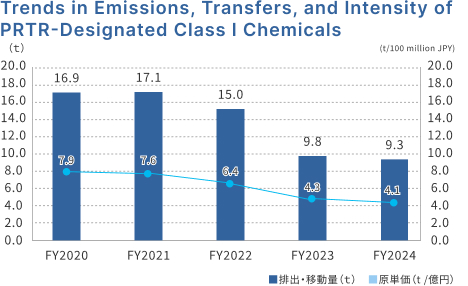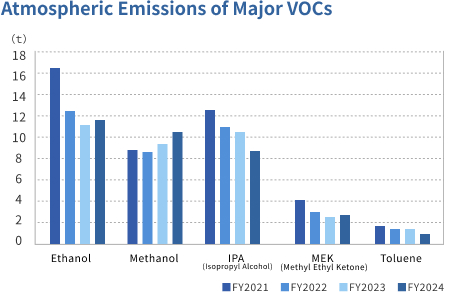Environment
Society
Human capital
- Human Rights
- Development of Human Resource
- Development of Global Human Resource
- Diverse human resources and diverse working styles
- Health Management to Enhance Corporate Value
- Occupational Safety and Health
- Occupational Safety and Health
- business Continuity
- Business Continuity Plan/Management (BCP/BCM)
- communication
- Procurement Activities
- Stakeholder Engagement
- Social Contribution Activities
Governance
Technological Strengths
Basic Concept
Based on the Environmental Management Activity guideline, Fujikura and its domestic group companies report to the government every year the amount of designated chemical substances discharged or transferred from each business that are used in product raw materials or manufacturing processes and that are handled in quantities of 1 ton or more as stipulated by the PRTR Law*.
*PRTR Law: Law concerning the promotion of understanding the amount of specific chemical substances released into the environment and the improvement of their management
Goals and Results
In its Environmental Management Activity guideline, Fujikura and its domestic group companies have set a target of reducing the amount of PRTR substances handled by "improving the emission and transfer volume of major environmentally hazardous substances per unit of sales by 4% or more compared to fiscal 2020 (annual improvement of 1% or more)" in fiscal 2024.
The main substances we handle, such as antimony, lead compounds, and bis(2-ethylhexyl) phthalate, are used as additives in plastics and rubber materials. Additionally, xylene and toluene are used in ink solvents and are contained in gasoline for transport vehicles. In an effort to reduce the amount of these chemical substances emitted and transferred, we are promoting the use of lead-free and eco-friendly products and the shift to alternative materials.
The volume of Class 1 designated chemical substances handled by Fujikura and its domestic group companies in fiscal 2024 was 125 tons, a 55% improvement compared to fiscal 2020, the volume emitted and transferred was 9.3 tons, a 45% improvement compared to fiscal 2020, and the intensity was 4.1 tons/100 million yen, a 48% improvement compared to fiscal 2020, achieving the target.

*Total value for Fujikura and domestic group companies
Reducing atmospheric emissions of volatile organic compounds (VOCs)
VOC is a general term for organic compounds that become gaseous in the atmosphere and are said to be the cause of suspended particulate matter and photochemical oxidants that affect human health.
In Fujikura Group 2025 Environmental Management Activity guideline, Fujikura and its domestic group companies have set a target for reducing VOC atmospheric emissions of at least 4% in the emissions intensity (per sales) of major VOCs in fiscal 2024 compared to fiscal 2020 (an annual improvement of at least 1%).
The VOC emissions for Fujikura and its domestic group companies in fiscal 2024 will be 37.8 tons, a 21% improvement from 47.9 tons in fiscal 2020, and the basic unit will be 16.6 tons per 100 million yen, a 26% improvement from fiscal 2020, achieving the target.



